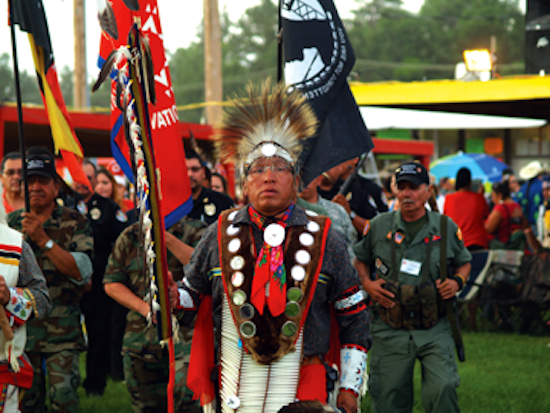
The Oglala Nation Pow wow 2014 Color guard. Photo by Karin Eagle
Listen to the Eyapaha at your next pow wow
By Karin Eagle
Native Sun News Staff Writer RAPID CITY — Every year around Indian Country thousands of Indian people celebrate their connections to tradition and spirituality, to the Earth and to one another, in a social, personal and spiritual meeting: the Powwow. These gatherings are an integral component of their existence as tribal people. More than just homage to a great ancestry, powwows, or Wacipi in the Lakota language is an event of contemporary significance for the individuals and communities. The Wacipi reflects upon many important aspects of Native American society. The beat of the drum; the stunning regalia; traditions and activities whose purpose is to communicate and strengthen the ways of the Native American community; family life and spirituality are almost always present regardless of the region in which a powwow is held. Most powwows begin with the Grand Entry. All spectators are asked to rise as the flags and eagle staffs of the host and visiting tribes are brought in. The Eyapaha, or village crier, is the voice of the pow wow. He or she directs the action and usually keeps things moving with a sharp wit and a great sense of humor. Butch Felix of Rosebud is an eyapaha who keeps everyone on their toes and brings smiles and outright laughter to those in attendance. He knows so many people that he often points out people by name and usually has something funny to say about them. There are famous pow wow announcers all over America from different sections of the country. Oklahoma is the home of several including Sammy “Tonekei” White and current Chairman of the Comanche Nation, Wallace Coffey. The Eagle staffs and flags represent nations, families, and communities and are presented as the drums begin a grand entry song. The chief or tribal chair of the host tribe and visiting dignitaries enter the arena. They are followed by other honored members and the color guard of veterans. Elected royalty are young people who have been chosen and honored by their specific home community to represent that community at events around the country and follow next in the procession. Led by the elders, the men dancers follow next, generally in the following order: men's traditional dancers, men's grass dancers and then men's fancy dancers. Then the women enter, also led by the elder women and in the order of women's traditional dancers, jingle dress dancers and then fancy shawl dancers. The teenage boys enter next, followed by the teenage girls and then the younger boys, girls and tiny tots. The tiny tots are the youngest of the tribes and are often referred to by the emcees as “The Greatest Show on Earth." The dancers in each category are announced as they pass the announce stand. Finally the arena is filled with all of the dancers each dancing in their grand regalia. Responsibility for maintaining the song passes from drum to drum, going around the circle until all dancers are in the center of the circle and dancing. With all remaining in the center of the circle, the prayer song and honoring song for veterans begin next. It is a spectacular sight filled with beauty and excitement and pride. The upcoming He Sapa Wacipi na Oskate, also referred to by its former name, The Black Hills Expo, will be held at the Rushmore Plaza Civic Center beginning Oct. 10 and continuing on through the twelfth. Watch for more information and useful links in this and upcoming issues of The Native Sun News as the event gets closer. (Contact Karin Eagle at staffwriter@nsweekly.com) Copyright permission Native Sun News
Join the Conversation
